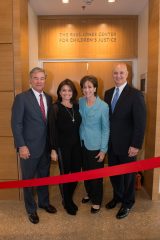In November we mentioned Dallas CASA had announced its 5-year, $37 million campaign, “Abused Children Can’t Wait,” in order to recruit more Court Appointed Special Advocates to ensure that every child in foster care has a CASA representative. That means Dallas CASA needed to double the number of volunteers within the next few years (and still does, if you’re looking for a volunteer opportunity).
In order to accommodate the new volunteers, Dallas CASA needed more office space. The organization already had maxed out its building at 2815 Gaston, so it began building a new building at Swiss and Texas in East Dallas.
In May, the Dallas CASA board of directors and staff were joined by Jan and Trevor Rees-Jones for a ribbon cutting ceremony and grand opening of its new 25,020 office facility east of downtown Dallas. Also attending the celebration were Dallas County government and judicial officials and area business and civic leaders.
The new building is three times the size of its previous building and houses The Rees-Jones Center for Children’s Justice. The space will be used to train more than 300 new CASA volunteers each year and provide continuing education for the more than 1,400 volunteers needed to serve all abused children in Dallas County, according to a press release. The facility also will be a center for collaboration with the child welfare community to help facilitate systemic change to transform the lives of abused children.
Dallas CASA is an organization of volunteers who are trained and supervised to advocate for the best interests of abused children in court. On an average day in Dallas County, more than 2,000 abused and neglected children live in foster care because they cannot live safely at home. The “Abused Children Can’t Wait” campaign will propel Dallas CASA to accomplish something no other major metropolitan area CASA program has done, by doubling the number of trained volunteers, increasing the number of staff and doubling the operating budget.







